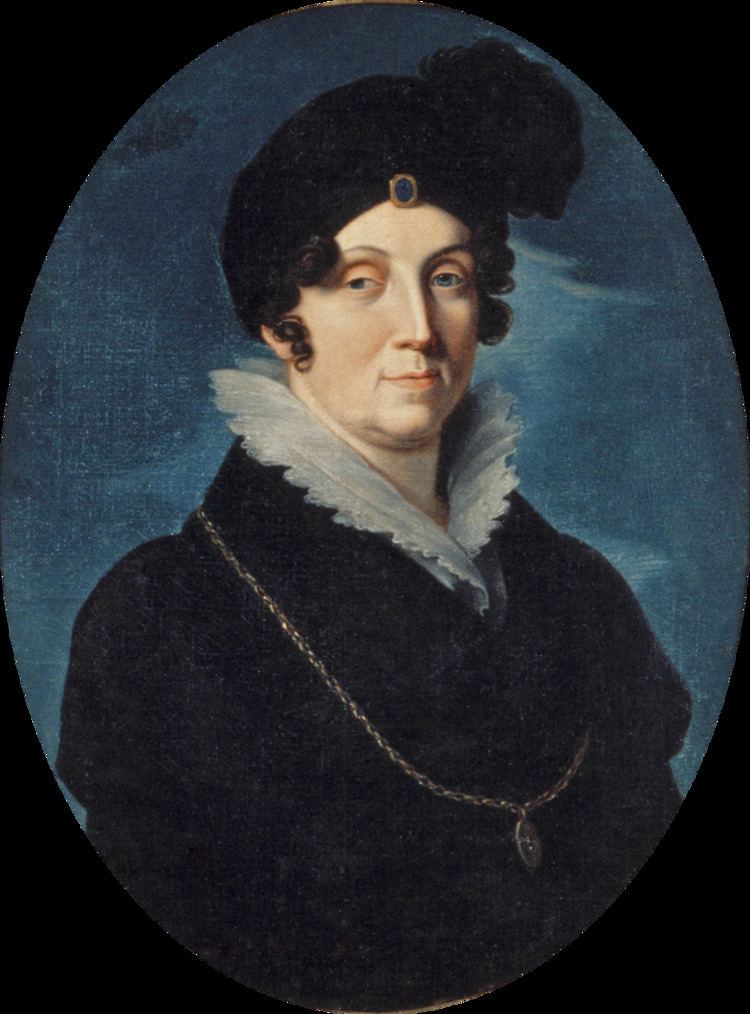House Hesse-Darmstadt | Name Princess of | |
 | ||
Born 20 June 1754Prenzlau ( 1754-06-20 ) Issue Katharine Amalie Christiane LuiseKaroline, Queen of BavariaLouise, Empress of RussiaFrederica, Queen of SwedenMarie, Duchess of Brunswick-WolfenbuttelKarl FriedrichKarl, Grand Duke of BadenWilhelmine, Grand Duchess of Hesse Father Ludwig IX, Landgrave of Hesse-Darmstadt | ||
Princess Amalie of Hesse-Darmstadt (20 June 1754 – 21 June 1832) was a Hereditary Princess of Baden by marriage to Charles Louis, Hereditary Prince of Baden. She was the daughter of Ludwig IX, Landgrave of Hesse-Darmstadt and Henriette Karoline of Palatine-Zweibrücken.
Contents
Life
Amalie was born in Prenzlau and was brought to St Petersburg with her mother in 1772 to visit the Russian court as one of the candidates for a marriage with the Tsarevich Paul Petrovich; Paul, however, decided upon her sister Wilhelmine.
Hereditary Princess of Baden
Amalie married her first cousin, Charles Louis, Hereditary Prince of Baden on 15 July 1775. He was the son of Margrave Charles Frederick (who in 1806, after his father's death, became the 1st Grand Duke of Baden) and Karoline Luise of Hesse-Darmstadt, the daughter of Ludwig VIII of Hesse-Darmstadt.
During her marriage, Amalie complained about her father-in-law's coldness and the childish behaviour of her husband. Amalie also missed the Prussian and Russian courts. She served ceremoniously as the first lady of the court from the death of her mother-in-law in 1783 until the marriage of her son in 1806. In 1801, she visited her daughter Empress Luise in Russia with her family, and thereafter her second daughter, the Swedish Queen Friederike, in Sweden in September 1801. During Amalie's stay in Sweden, she was described as witty, intelligent and correct, and fully dominated her spouse. They visited Drottningholm Palace and Gripsholm and Amalie befriended Hedwig Elizabeth Charlotte of Holstein-Gottorp, which was disliked by the King, and reprimanded her daughter about her stiff and unfriendly manners in public. Her spouse died due to an accident before their departure, and she remained in Sweden with her family until May 1802. Shortly before her departure, she was inducted in the Yellow Rose lodge of Karl Adolf Boheman, by him referred to as a branch of the Freemasons.
Later years
During her visits in Russia and Sweden she made attempts to reconcile her sons-in-law, the Russian and Swedish monarchs with each other. In 1803, she received the royal Swedish family as guests in Baden, during which it was said that she had the chance to gain influence over her son-in-law, as she was lovable and amusing, had a lively interest in politics and the same views as him. It was said of Amalie that: "The Landgravine of Baden could in power hunger and will force measure up to that of Catherine II". As an opponent of Napoleon Bonaparte, she had tried to prevent the wedding of her son to Stéphanie de Beauharnais, and after their wedding in 1806, she retired to her widow estate at Schloss Bruchsal in the Kraichgau. In 1807, Amalie sent her daughter, Queen Frederica of Sweden, a letter from her second daughter, the Empress of Russia, in an attempt to convince Frederica to use her influence to persuade her spouse to make peace between Sweden and Napoleon, which did not succeed.
In 1809, she received her daughter Frederica and her family upon the deposition of her son-in-law from the Swedish throne. In 1811, she tried to persuade Gustav Adolf not to divorce Frederica, but when it proved necessary, she arranged for her daughter's economic independence and the custody of her grandchildren. In 1815, her grandson Gustav of Sweden was referred to as "Prince of Sweden" in an announcement from the Baden court, which caused protests from Jean Baptiste Bernadotte, who believed it to have been instigated by Amalie, as she had a reputation for plotting, in an attempt to secure a throne for her grandson. During the Congress of Vienna in 1815, Amalie's influence upon her son-in-law Tsar Alexander I contributed to the fact that Baden was allowed to remain a Grand Duchy without loss of territory.
She died in Bruchsal, aged 78, having outlived her husband and six of their eight children.
